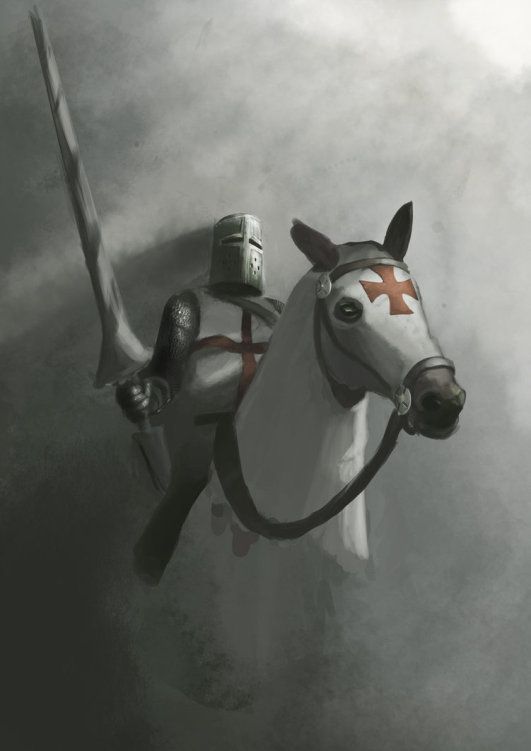The secrecy around the powerful medieval Order of the Knights Templar, and the speed with which they disappeared over the space of a few years, has led to Knights Templar legends. These range from rumors about their association with the Holy Grail and the Ark of the Covenant, to questions about their association with the Freemasons, to searches for a lost treasure.
Speculation about the Templars has increased because of references to them in bestselling books such as The Da Vinci Code and films such as Indiana Jones and the Last Crusade and National Treasure.
Jerusalem Temple
Legends surround the location of the Templars' first headquarters on the Temple Mount, which had been assigned to them by King Baldwin II of Jerusalem. They were in operation there for 75 years.
The Temple Mount is sacred ground to Jews, Christians, and Muslims, and is the location of the ruins of Solomon's Temple, and the ancient resting place of the Ark of the Covenant.
Pseudo-historical books such as The Holy Blood and the Holy Grail theorise that the Templars could have discovered documents hidden in the ruins of the Temple, possibly "proving" that Jesus survived the Crucifixion or possibly "proving" Jesus was married to Mary Magdalene and had children by her. Indeed, the supposition that the Templars must have found something under the Temple Mount lies at the heart of most Templar legends and pseudo-historical theories, also popularised by French author Louis Charpentier.
There is no physical or documentary evidence, however, to support such a supposition. It is true that they are documented as having carried a piece of the True Cross into some battles, but this was likely a portion of a timber that was discovered during the 4th century by Saint Helena, the mother of Emperor Constantine.
Relics
Other legends of modern invention say that the Holy Grail, or Sangreal, was found by the Order and taken to Scotland during the suppression of the order in 1307, and that it remains buried beneath Rosslyn Chapel. Other more recent discoveries say the Holy Grail was taken to Northern Spain, and protected by the Knights Templar there.
Some sources claim that the Templars discovered secrets of the Masons, builders of Solomon's Temple, Zerubbabel's Temple, and Herod's Temple at the Temple Mount, along with knowledge that the Ark had been moved to Ethiopia before the destruction of the first temple.
Allusion to this is made in engravings on the Cathedral at Chartres, the construction of which was greatly influenced by Bernard of Clairvaux, the Order's patron. Further links to both the search by the order for the Ark and to its discovery of ancient secrets of building are supposedly suggested by the existence of the monolithic Church of Saint George in Lalibela, Ethiopia, which stands to this day but whose construction is incorrectly attributed to the Knights Templar.
Some scholars, such as Hugh J. Schonfield, and fringe researchers argue that the Knights Templar may have found the Copper Scroll treasure of the Qumran Essenes in the tunnels beneath the Temple Mount. They suggest that this might explain one of the charges of heresy which were later brought against the knights by the Medieval Inquisition.
Deaths of the Order's enemies
The last Grand Master of the Templar Order, Jacques de Molay, was burned at the stake in 1314, by order of King Philip IV of France, who had also pressured Pope Clement V to disband the Order. Legend has it that de Molay issued his dying curse against the King and Pope Clement V, saying that he would meet them before God before the year was out.
Pope Clement died only a month later, and King Philip died later that year in a hunting accident. Malcolm Barber has researched this legend and concluded that it originates from La Chronique métrique attribuée à Geffroi de Paris (ed. A. Divèrres, Strasbourg, 1956, pages 5711-5742). Geoffrey of Paris was "apparently an eye-witness, who describes Molay as showing no sign of fear and, significantly, as telling those present that God would avenge their deaths".
Albert Pike claimed the Knight Kadosh, the 30th degree within the Ancient Accepted and Scottish Rite, commonly known as a 'Vengeance degree', involved the trampling on the Papal tiara and the royal crown, destined to wreak a just vengeance on the high criminals for the murder of de Molay.
The figure of Hiram Abiff representing Jacques de Molay, with the three assassins representing Philip IV of France, Pope Clement V and Squin de Florian. Malcolm Barber has cited a masonic legend that resembles Pike's claims, in Louis Claude Cadet de Gassicourt Le Tombeau de Jacques Molai (Paris, 1796, first edition).
Many believed that the dynasty had been cursed. A series of 20th century novels called Les Rois Maudits (The Accursed Kings) by Maurice Druon expanded on this story.
A frequent recurring legend relates how when Louis XVI was guillotined, an anonymous French Freemason rushed from the crowd, dipped his hand in the king's blood (or grabbed the head and held it) and yelled, "Jacques de Molay, thou art avenged!" This story first appeared in The Illuminatus! Trilogy, a work of science fiction, in 1975.
Friday the 13th
Many modern stories claim that when King Philip IV had many Templars simultaneously arrested on October 13, 1307, that started the legend of the unlucky Friday the 13th. However, closer examination shows that though the number 13 was indeed considered historically unlucky, the actual association of Friday and 13 seems to be an invention from the early 20th century.
Source: http://en.wikipedia.org/wiki/Knights_Templar_legends








No comments:
Post a Comment